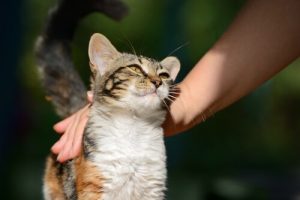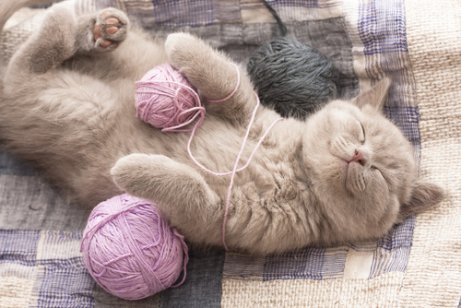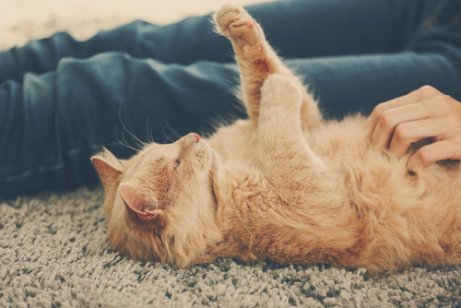Purring: Why do cats do it?

If there is anything that makes cats stand out, it has to be the peculiar sound they make. Experts are still trying to figure out what purring means and how cats do it. Read this article to find out everything you’ve ever wanted to know about cats’ purring.
A difficult sound to define
How do you accurately define ‘purr’? Merriman-Webster defines the word as “a low vibratory murmur” that a cat makes when it is happy.
However, experts have shown that purring is not only an expression of happiness. It can also be associated with pain or anguish, which is something that will be covered later on in this article.
Purring has also been described as a buzzing, soft and continuous. It’s accompanied by a vibration that you can see and feel in the body of the cat. Likewise, purring varies with breathing and seems to become more audible and intense at times.
Cats start purring a few days after birth. This sound is essential for communicating with the mother. Mother cats even purr to calm down the kittens during birth and during breastfeeding.
For several reasons — such as happiness and pain – and due to mechanisms that are not fully understood, cats purring continues to arouse people’s curiosity. At the same time, purring is good for the physical and mental health of the people who live the cat.

Theories About Why Cats Purr
Experts still don’t fully understand how a cat is able to purr. In the 60’s, a “hemodynamic” theory was proposed. This theory says that purring is produced by blood passing through the posterior vena cava.
Later, people believed that it comes from the vibrations in the soft palate. Nowadays, one of the most accepted theories is that it is due to a modulation of the airflow when a larynx purrs.
Technically, the sound is believed to come from a contraction of the laryngeal muscles. There is a partial and repetitive closure of the glottis. Due to this, there are variations in the air pressure that passes through the organ, which produces the typical purring vibration.
The contractions of the diaphragm while the cat breathes could explain why this sound is more or less continuous.
Why cats purr
But, after all this, the million dollar question remains: why do cats purr? Everything would seem to indicate that it expresses that the cat is comfortable or happy when, for example, we pet it.
However, cats also purr when they are scared, sick, or suffering pain or a stressful situation. People have even observed purring in cats that are about to die.

In any case, purring seems to play a role in reassuring the cat or comforting it. Experts have proven that cats release endorphins when they purr. These substances are related to pleasurable situations, and they are good for relieving pain.
Likewise, we shouldn’t rule out that purring be helpful for a cat to recover on his own. Cats purr at a frequency between 25 and 150 Hz. This, among other things, could help increase bone density, repair tendons, or even heal wounds.
One thing that is for sure is that purring isn’t a monotone sound. Everything seems to indicate that cats purr according to the situation they are facing.
Healing Purrs
Cats’ self-healing mechanisms also seem to influence cat owners. There are several studies that have the research that can back this up.
For example, people who pet cats on a daily basis could experience the following benefits:
- Lower stress levels
- Better sleeping patterns
- Have fewer heart problems
- Better regulated blood pressure
- Improved immune system
- Overcome infections faster
- Easily heal bones, muscles, and tendons
Therefore, if you have a cat, it’s possible that you could have fewer doctor appointments that the normal catless human being. So relax, pet your cat, and take advantage of their healing purrs.
If there is anything that makes cats stand out, it has to be the peculiar sound they make. Experts are still trying to figure out what purring means and how cats do it. Read this article to find out everything you’ve ever wanted to know about cats’ purring.
A difficult sound to define
How do you accurately define ‘purr’? Merriman-Webster defines the word as “a low vibratory murmur” that a cat makes when it is happy.
However, experts have shown that purring is not only an expression of happiness. It can also be associated with pain or anguish, which is something that will be covered later on in this article.
Purring has also been described as a buzzing, soft and continuous. It’s accompanied by a vibration that you can see and feel in the body of the cat. Likewise, purring varies with breathing and seems to become more audible and intense at times.
Cats start purring a few days after birth. This sound is essential for communicating with the mother. Mother cats even purr to calm down the kittens during birth and during breastfeeding.
For several reasons — such as happiness and pain – and due to mechanisms that are not fully understood, cats purring continues to arouse people’s curiosity. At the same time, purring is good for the physical and mental health of the people who live the cat.

Theories About Why Cats Purr
Experts still don’t fully understand how a cat is able to purr. In the 60’s, a “hemodynamic” theory was proposed. This theory says that purring is produced by blood passing through the posterior vena cava.
Later, people believed that it comes from the vibrations in the soft palate. Nowadays, one of the most accepted theories is that it is due to a modulation of the airflow when a larynx purrs.
Technically, the sound is believed to come from a contraction of the laryngeal muscles. There is a partial and repetitive closure of the glottis. Due to this, there are variations in the air pressure that passes through the organ, which produces the typical purring vibration.
The contractions of the diaphragm while the cat breathes could explain why this sound is more or less continuous.
Why cats purr
But, after all this, the million dollar question remains: why do cats purr? Everything would seem to indicate that it expresses that the cat is comfortable or happy when, for example, we pet it.
However, cats also purr when they are scared, sick, or suffering pain or a stressful situation. People have even observed purring in cats that are about to die.

In any case, purring seems to play a role in reassuring the cat or comforting it. Experts have proven that cats release endorphins when they purr. These substances are related to pleasurable situations, and they are good for relieving pain.
Likewise, we shouldn’t rule out that purring be helpful for a cat to recover on his own. Cats purr at a frequency between 25 and 150 Hz. This, among other things, could help increase bone density, repair tendons, or even heal wounds.
One thing that is for sure is that purring isn’t a monotone sound. Everything seems to indicate that cats purr according to the situation they are facing.
Healing Purrs
Cats’ self-healing mechanisms also seem to influence cat owners. There are several studies that have the research that can back this up.
For example, people who pet cats on a daily basis could experience the following benefits:
- Lower stress levels
- Better sleeping patterns
- Have fewer heart problems
- Better regulated blood pressure
- Improved immune system
- Overcome infections faster
- Easily heal bones, muscles, and tendons
Therefore, if you have a cat, it’s possible that you could have fewer doctor appointments that the normal catless human being. So relax, pet your cat, and take advantage of their healing purrs.
This text is provided for informational purposes only and does not replace consultation with a professional. If in doubt, consult your specialist.








